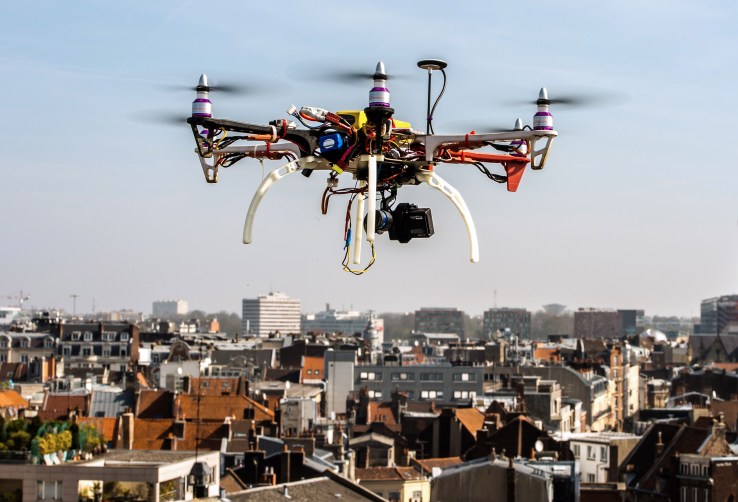
As drones increasingly fly through our cities in the coming years delivering our latest order from Amazon or other on-demand retailers the regulation of our airspace and the environment in which we co-exist with flying robots becomes more and more present and real.
The conceptual shift that we have gone through even with the term drone is quite dramatic. Mentioning drones in conversation two years ago might have prompted thoughts of warfare, human rights or national defense strategy. Now commerce is top of mind.
In fact, when we talk about drones today, the average person most likely thinks about how retailers could deliver goods to them, whether another hobbyist has been flying too close to airports or even the White Houseor even how local governments can use them to monitor infrastructure. The way we think of drones and the things we use them for is changing
When it comes to drone usage and operation, there is a critical role for cities both in relation to community residents using these tools and through the regulation of the space we all enjoy and use every day. The Federal Aviation Administration (FAA) predicts there will be 7 million drones in use by 2020, so it is not a matter of when cities will have to deal with them, but how.
From the government standpoint, there are a range of areas where drones can be incredibly useful. This technology has the potential to replace potentially hazardous operations like fire-fighting or infrastructure inspection, help find missing persons, allow construction crews to monitor sites for safety hazards and empower hospitals to transport urgently needed medication to remote locations.
Additionally, many retailers, like 7-Eleven and Walmart, are exploring the use of drone technology for delivery service. The increased accessibility and popularity of drones has everyone ranging from realtors to inspectors to photographers and others clambering to use them to better analyze the world around them. Drones have the potential to revolutionize many industries, particularly as their technology advances.
However, drones also present challenges for cities. They raise safety, privacy, nuisance and trespassing concerns, all of which are compounded by the lack of accountability associated with most drone operations.
Cities will be the critical connector that brings together this future we are all flying toward.
There are safety issues that must be faced, for instance, when operators fly drones over people or near planes. Additionally, city residents often have privacy concerns when any small device hovering nearby could potentially be taking photos or video. The fear of a drone trespassing into previously non-shared space is heightened when these vehicles can be operated remotely. This anonymity makes it increasingly difficult to identify operators who fly recklessly, harass individuals or cause injury to persons or property.
Cities and Dronesserves as a primer on drones for local officials, providing insight on the recently released FAA rules relating to drone operation, as well as offering suggestions for how local governments can craft their own drone ordinances to encourage innovation while also protecting their cities.
The helpful thing about the FAA rule is that it moved to establish categories for operators, guidelines for safe operations and a minimum threshold for FAA investigations. This allows local and state authorities to still have an opportunity to legislate on appropriate operating space and behavior, as well as enforcement. Our new report makes recommendations for how cities can focus their energy when enacting their own drone-related ordinances.
The power of land use and zoning helps cities designate when and where drones may take off, land and operate, as well as any operational limitations or criteria. Additionally, cities can punish operators for operating an unmanned aircraft in a manner that recklessly endangers persons or property while considering appropriate enforcement infrastructure.
Both commercial and recreational drone operation can powerfully benefit cities, and rather than ban them outright, cities have an opportunity to consider how this new technology might serve or enhance city operations and residents.
Additionally, the startup activity that the new regulatory environment should facilitate could be a boon to economic development efforts in cities. With the rules of the road now established, businesses that want to use drones as auxiliary business tools or start whole new services will be well-served moving forward.
The lines between convenience and privacy continue to be blurred across so many emerging disruptive technologies and frankly, the idea of regulating airspace that is so (physically) close to people is something that is rightfully concerning, because people dont want drones dropping on their heads or looking in their windows.
When the previously unimaginable becomes the new normal, it is critical to have our mayors and other local leaders out in front to address these abrupt transitions. At the end of the day, certain aspects of drone regulation might look different in different places depending upon the type of activity taking place.
It is necessary for city officials to address the spheres of drone activity that will most impact our cities, from private to commercial and public use. As drones whirring overhead become mainstream, we will become more familiar and comfortable with them as tools, rather than threats.
The enhancement and development of this technology presents a number of opportunities for cities. The challenge for local elected officials will be crafting policy and regulations that enable this drone technology to serve their cities in the best, most appropriate ways, embracing innovation while still considering safety.
Cities play such a vital role in the ongoing autonomization of society. Within this broader shift toward autonomous vehicles, robots in the workplace and broader community life, and, of course drones, city leaders share the primary goal to protect their community members while promoting innovation and economic growth. As drones fly through the sky and land on lawns, rooftops and more, cities will be the critical connector that brings together this future we are all flying toward.





![[Video] How to get rid of bed bugs in Toronto](https://www.thehowtozone.com/wp-content/uploads/2019/10/maxresdefault-2-100x70.jpg)


